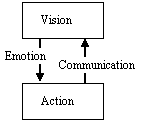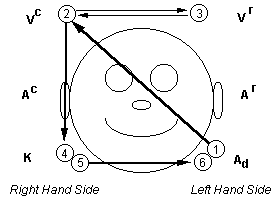New Behavior Generator Strategy
One of the most essential processes of change is that of moving from a dream or vision to action. NLP has developed a kind of 'all purpose' creativity strategy, organized around the process of moving from vision to action, called 'The New Behavior Generator'. The basic steps to the New Behavior Generator were set out by John Grinder in the late 1970's.
The New Behavior Generator is an elegant strategy that can be applied to almost any situation that involves personal flexibility. The basic steps involve forming a visual image of a desired behavior, kinesthetically associating into the image on a feeling level, and verbalizing any missing or needed elements.

New Behavior Generator T.O.T.E.
These three steps form a feedback loop in which vision and action interact through the intermediate processes of emotion and communication.
The goal of the New Behavior Generator is to go through a type of mental 'dress rehearsal' by generating imaginary scenarios and bringing them to concrete actions by connecting the images to the kinesthetic representational system. The strategy is based on several key beliefs:
People learn new behaviors by creating new mental maps in their brains.
The more complete you make your mental maps, the more likely you will be to achieve the new behavior you want.
Focusing on your goal is the quickest way to achieve new behaviors.
People already have the mental resources they need to achieve new behaviors. Success is a function of accessing and organizing what is already there.
The New Behavior Generator is a 'How To' process that both expresses and supports these beliefs through the process of acting "as if". Like all NLP strategies, the New Behavior Generator follows a particular cognitive sequence, made up of processes involving the various sensory representational systems. Each step in the sequence is also supported by behavioral cues in the form of eye movements. These eye positions help to focus and stabilize the particular representational system to be accessed.
Basic Steps of the New Behavior Generator Strategy
The basic steps of the New Behavior Generator Strategy involve:
Asking yourself, "If I could already achieve my new goal, what would I look like?"
(Do this while putting your eyes down and to your left.)
Picturing yourself achieving your goal. (Look up and to your right to help stimulate your imagination.)
To help you visualize:
Remember a similar successful achievement.
Model someone else.
Picture yourself first achieving a smaller part of the goal.
(Move your eyes up and to the left or right.)
Stepping into the picture so you feel yourself doing what you pictured.
(Put your eyes and head down and to the right as you get into the feeling.)
Comparing these feelings to feelings from a similar past success.
(Keep your eyes and head turned down and to the right.)
If the feelings are not the same, name what you need and add it to your goal. Go back to step 1 and repeat the process with your expanded goal.
(Move your eyes and head down and to the left.)

Sequence of Accessing Cues for New Behavior Generator Strategy
Detailed Description of the Steps of the New Behavior Generator Strategy
Each of the basic steps of the New Behavior Generator Strategy can be done with precision and rigor in order to enhance its practical effects. The following is a detailed description of each step in the strategy:
Say to yourself, "If I was already able to…(state your goal)…what would I look like?" (Ad)
Construct a visual image of what you would look like if you were in the act of achieving the full goal you have just stated. You should be seeing yourself in this image from a disassociated point of view as if you were above or next to yourself looking at yourself. (Vc)
If you have trouble coming up with a clear image of yourself, use one of the following strategies:
Chunk down your goal into smaller steps. Ask yourself, "Is there any portion of my goal that I can see myself achieving?" for instance, "Can I see myself accomplishing the first step of my stated goal?" Visualize yourself successfully achieving that smaller part of your goal. (Ad_>Vc)
Use an image of yourself from a similar successful situation. Ask yourself, "Is there something similar to my goal that I can already achieve?" Visualize what you do in that situation and edit or modify the image to fit your current goal. (Ad_>Vr_>Vc)
Model someone else. Ask yourself, "Who do I know that is already able to fully achieve the goal I have stated?" Visualize the what this other person does to be successful. Then visualize yourself doing what you just saw your model doing. (Ad_>Vr_>Vc)
Mentally step inside of the image you created of yourself achieving your goal so that you feel as though you are doing right now what you just saw yourself doing. What would you be seeing, hearing and feeling? (Vc_>Kc)
Compare the feelings you have as you put yourself fully into that experience with the feelings you identified earlier from a similar experience in which you are already successful. (Kc/Kr)
Decision Point
If the two feelings match exactly so that you feel as confident that you can achieve your new goal as easily as the goal you have already achieved successfully, then you are done.
If the two feelings do not match then name what is missing or what is needed (i.e., "creativity," "more confidence," "be more relaxed," etc.).
Apply the same rule to this statement of the needed resource that you applied to your initial goal statement. That is, state it positively. For example, if your statement of what is needed is "be less nervous," ask yourself, "If I could be less nervous what would I be doing instead?" (Ad)
Refine your goal by taking the name of the needed resource that you have identified and adding it to your goal statement by simply connecting it with the word "and." For example, the goal statement may now be something like, "I want to be more assertive with my co-workers (initial goal statement) AND keep in mind their feelings as well." Go back to step #1 and repeat the strategy. (Ad)
| 1. State Goal In Positive Form |
2. Visualize Yourself Achieving It |
4. 5. Does It Feel Like I Can Really Do It? |
6. 7. Name What Is Needed Or What Is Missing |
|---|

Specific Steps of the New Behavior Generator Strategy
NOTE: You may add any number of needed resources to your goal statement so that when you are done you may have refined your goal to something like: "I want to be more assertive with my co-workers AND keep their feelings in mind as well AND maintain a sense of my own self confidence AND remain cool if someone gets angry."
